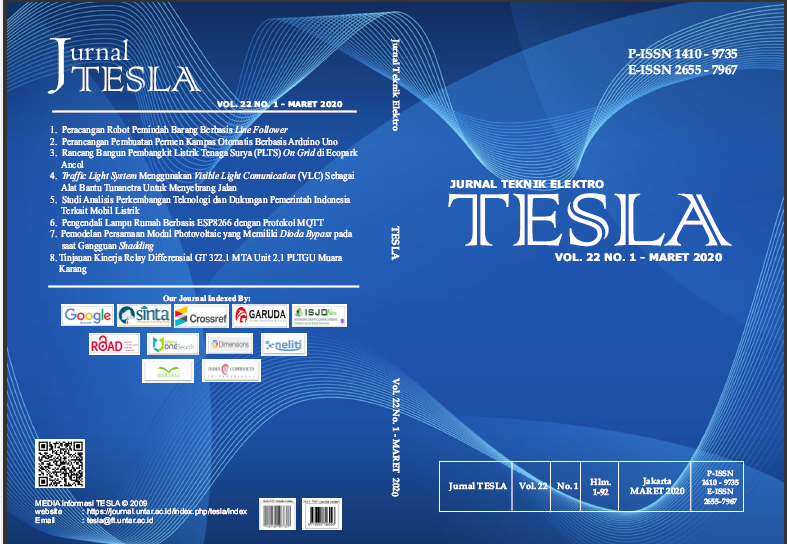PEMODELAN PERSAMAAN MODUL PHOTOVOLTAIC YANG MEMILIKI DIODA BYPASS PADA SAAT GANGGUAN SHADING
Main Article Content
Abstract
ABSTRAK:Modul Photovoltaic (PV) adalah perangkat yang mengubah sinar matahari menjadi energi listrik. Penggunaan modul PV menjadi semakin populer dari waktu ke waktu. Pada kondisis tertentu, modul PV dapat mengalami gangguan. Salah satu gangguan dalam penggunaan modul PV adalah shading. Shading adalah kondisi di mana sinar matahari terhalangi oleh suatu objek, di mana objek tersebut menghasilkan bayangan pada permukaan modul PV yang mengakibatkan berkurangnya produktifitas dan efisiensi dari pembangkitan listrik. Gangguan shading dapat terjadi pada satu sel PV atau beberapa sel PV yang tidak hanya mengakibatkan berkurangnya pembangkitan listrik secara drastis tetapi juga kerusakan struktur dan kebakaran. Pemodelan persamaan diperlukan untuk merepresentasi karakteristik daya, arus dan tegangan pada saat terjadinya gangguan shading. Metode yang digunakan pada penelitian tersebut adalah sintesa dari beberapa metode yaitu pemodelan detail persamaan modul PV dan memvariasikan besaran gangguan shading pada modul PV menggunakan program Simulink MATLAB. Hasil dari penilitan memperlihatkan karakteristik arus dan tegangan dan karakteristik daya dan tegangan merepresentasikan modul PV pada saat mengalami shading di mana hasil tersebut dapat dianalisis dan digunakan untuk penelitian yang lebih lanjut dan pengembangan dari perangkat PV dan sistem PV
Article Details
This work is licensed under a TESLA: Jurnal Teknik Elektro Creative Commons Attribution-ShareAlike 4.0 International License. 
References
Muhammad H Rashid, Power electronics: circuits, devices, and applications Fourth Edition. Harlow: Pearson, 2014.
I. Md. Rabiul, K. R. Naruttam, and R. Saifur, Renewable energy and energy sources. 2018.
R. Ehrlich and H. A. Geller, Renewable energy, second edition: A First Course. 2017.
T. Afrin Chandel, M. A. Mallick, and M. Y. Yasin, “Performance of partially shaded solar photovoltaic system,” Int. J. Recent Technol. Eng., vol. 7, no. 6, pp. 1444–1449, 2019.
W. Opare, C. Kang, Y. Gu, and N. Mao, “Combination effects of roof coating and solar photovoltaic system in the tropical region of Ghana: A case study,” Energy Explor. Exploit., vol. 37, no. 5, pp. 1455–1476, 2019, doi: 10.1177/0144598718803228.
R. V. F. Batista, “The impact of shadowing in photovoltaic systems and how to minimizing it,” 2018.
G. Conibeer and A. Willoughby, Solar Cell Materials: Developing Technologies. John Wiley & Sons, Ltd, 2014.
M. Gul, Y. Kotak, and T. Muneer, Review on recent trend of solar photovoltaic technology, vol. 34, no. 4. 2016.
K. Abdulmawjood, S. S. Refaat, and W. G. Morsi, “Detection and prediction of faults in photovoltaic arrays: A revie


